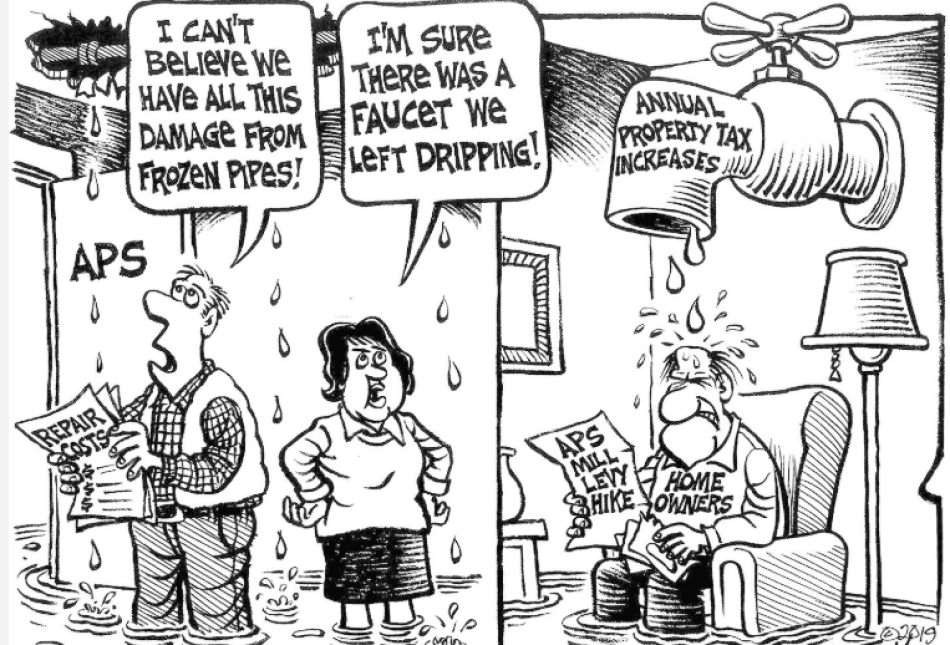APS tax increase: Is it worth it? No


Ballots for the Albuquerque Public Schools special mail-in election are showing up in mailboxes. Voters have until Feb. 5 to mail their ballots back to ensure they are counted. Voters should beware that they will be asked to vote on a major property tax increase this election.
Currently, Albuquerque Public Schools receives approximately 1/4th of the property taxes paid locally. If voters pass this tax hike they will soon be paying 19 percent more in property tax to the district. Even if you take the APS rate hike as a percentage of your overall property tax bill, it is a robust 4.7 percent property tax hike.
As if that is not bad enough, APS is spending more than 1 million of our tax dollars just to hold this special mail-in election now rather than waiting for the municipal elections to be held later this year.
If adopted, this tax hike will impact everyone who lives in or owns a business in the APS district. This includes the North and South Valleys outside of the city as well as Corrales and the East Mountains. Even if you rent, your landlord will pay higher taxes and will pass along the cost – and maybe a bit more.
This tax hike will have the most detrimental impact on older residents on fixed incomes and those, especially the young, who are just starting out and on tight budgets. APS has sent out a flier arguing that jobs and economic activity will result from this tax hike, but the reality is that this tax hike is a massive wealth transfer from average taxpayers to the District and its contractors.
Not one penny of this tax hike will go to hire new or better teachers. This money will be spent on capital projects like buildings, not on educational personnel in the classroom. According to APS’ own budget document, the district has about 83,000 students in 141 school buildings. APS last had 83,000 students in 2003 and it educated those students in “just” 124 school buildings. Rather than raising taxes to build even more facilities, perhaps APS should combine and sell off under-used and unnecessary facilities?
It would also seem that APS has failed to prioritize student needs in its recent construction budgets. In addition to the massive “twin towers” facility in Uptown, the district recently spent $22 million to build a new “training” center on Louisiana and Comanche, which a vast majority of students will never step foot in.
Aside from selling off and consolidating unnecessary facilities and properties, there are numerous ways that APS could save money on construction costs.
New Mexico has a “prevailing wage” law in effect, which arbitrarily increases the cost of labor on construction projects like schools. Ohio has such a law in place as well but exempted school construction. A 2002 report from Ohio’s non-partisan Legislative Service Commission found an overall savings of 10.7 percent on school construction projects. Even if APS only saved some portion of that it would be worth doing, but APS never discusses prevailing wage when it talks about rising construction costs.
If you’re suffering from high interest rate charges, transfer your debt to one of these…
APS could also save money by using modular construction. A 2016 KPMG report estimated 7 percent savings from such techniques. These are not the “trailer-style” temporary buildings often seen at our schools, but fully-functional, efficient buildings built faster and cheaper than traditional schools.
I write this not just as the head of a think tank. I have two children that attend school at APS. The district has plenty of resources, especially when it comes to facilities, but it needs to manage them more efficiently.
Voters in APS have been very generous in approving APS construction bonds over the years. (This) is a massive, unnecessary tax hike. It is time for voters to demand APS does more with what it already has before forcing taxpayers to cough up more of their hard-earned money.
The Rio Grande Foundation is an independent, non-partisan, tax-exempt research and educational organization dedicated to promoting prosperity for New Mexico based on principles of limited government, economic freedom and individual responsibility.
